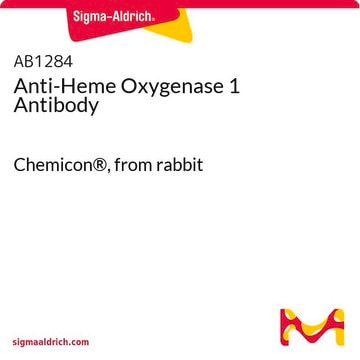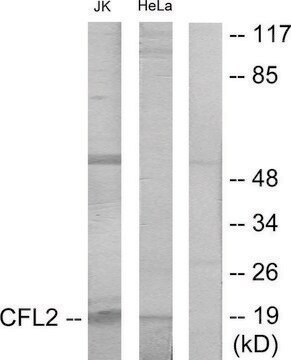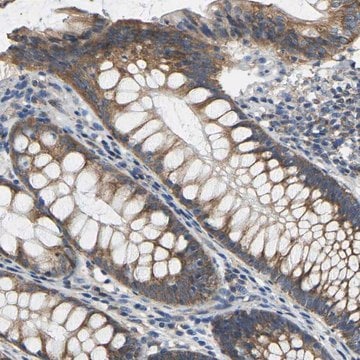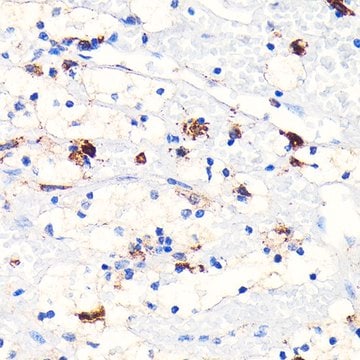一般說明
We are committed to bringing you greener alternative products, which adhere to one or more of The 12 Principles of Green Chemistry.This antibody is Preservative-free, produced without the harm or sacrifice of animals and exceptionally stable to allow for ambient shipping and storage if needed and thus aligns with "Waste Prevention", "Designing Safer Chemicals" and "Design for Energy Efficiency".
Click here for more information.
ZooMAb® antibodies represent an entirely new generation of recombinant monoclonal antibodies.
Each ZooMAb® antibody is manufactured using our proprietary recombinant expression system, purified to homogeneity, and precisely dispensed to produce robust and highly reproducible lot-to-lot consistency. Only top-performing clones are released for use by researchers. Each antibody is validated for high specificity and affinity across multiple applications, including its most commonly used application. ZooMAb® antibodies are reliably available and ready to ship when you need them.
特異性
Clone 1F8 is a ZooMAb® Rabbit recombinant monoclonal antibody that specifically detects Heme Oxygenase 1. It targets an epitope within 23 amino acids from the C-terminal region.
免疫原
KLH-conjugated linear peptide corresponding to 23 amino acids from the C-terminal region of human Heme Oxygenase 1.
應用
Quality Control Testing
Evaluated by Western Blotting in HepG2 cell lysate.
Western Blotting Analysis: A 1:1,000 dilution of this antibody detected Heme Oxygenase 1 in HepG2 cell lysate.
Tested applications
Immunohistochemistry (Paraffin) Analysis: A 1:1,000 dilution from a representative lot detected Heme Oxygenase 1 in human spleen tissue sections.
Immunocytochemistry Analysis: A 1:100 dilution from a representative lot detected Heme Oxygenase 1 in HepG2 cells.
Note: Actual optimal working dilutions must be determined by end user as specimens, and experimental conditions may vary with the end user
標靶描述
Heme oxygenase 1 (UniProt: P09601; also known as EC:1.14.14.18, HO-1) is encoded by the HMOX1 (also known as HO, HO1) gene (Gene ID: 3162) in human. HO-1 is a rate limiting enzyme in heme catabolism. Along with cytochrome p450 reductase and in the presence of molecular oxygen and NADPH, it catalyzes the oxidative cleavage of heme to produce equimolar amounts of biliverdin, ferrous iron (Fe2+), and carbon monoxide. Biliverdin can then be converted to bilirubin by biliverdin reductase (BVR). HO-1 is normally expressed at low levels in most tissues but can be induced by a variety of stimuli. Under normal physiological conditions, high activity of HO-1 is observed in the spleen, where senescent erythrocytes are sequestrated and destroyed. HO-1 plays a cytoprotective role because excess amount of free heme can sensitize cells to undergo apoptosis. Higher levels of HO-1 have been observed during inflammation, ischemia, hypoxia, hyperoxia, hyperthermia, or exposure to radiation. Due to its antioxidant, anti-inflammatory, and anti-apoptotic properties, it is protective against vascular inflammatory process. Its expression is significantly increased in cancer cells. Although it is primarily localized in the endoplasmic reticulum, its nuclear localization is also observed in cancer cells where it can facilitate tumor growth and invasion independent of its enzymatic activity. Mutations in HMOX1 gene can lead to HO-1 deficiency that leads to marked erythrocyte fragmentation and intravascular hemolysis, coagulation abnormalities, endothelial damage, and iron deposition in renal and hepatic tissues. Heme oxygenase is reported to be involved in the chemoresistance of breast cancer cells by preventing apoptosis and autophagy. This ZooMAb® recombinant monoclonal antibody, generated by our propriety technology, offers significantly enhanced specificity, affinity, reproducibility, and stability over conventional monoclonals. (Ref.: Chau, LY. (2015). J. Biomed. Sci. 22; Article 22; Zhu, XF., et al. (2015). 10(5); 2974-2980; Araujo, JA., et al. (2012). Front. Pharmacol. 3; 119).
外觀
Purified recombinant rabbit monoclonal antibody IgG, lyophilized in PBS, 5% Trehalose, normal appearance a coarse or translucent resin. The PBS/trehalose components in the ZooMAb formulation can have the appearance of a semi-solid (bead like gel) after lyophilization. This is a normal phenomenon. Please follow the recommended reconstitution procedure in the data sheet to dissolve the semi-solid, bead-like, gel-appearing material. The resulting antibody solution is completely stable and functional as proven by full functional testing. Contains no biocide or preservatives, such as azide, or any animal by-products. Larger pack sizes provided as multiples of 25 μL.
重構
300 μg/mL after reconstitution at 25 μL per vial. Please refer to guidance on suggested starting dilutions and/or titers per application and sample type.
儲存和穩定性
Recommend storage of lyophilized product at 2-8°C; Before reconstitution, micro-centrifuge vials briefly to spin down material to bottom of the vial; Reconstitute each vial by adding 25 μL of filtered lab grade water or PBS; Reconstituted antibodies can be stored at 2-8°C, or -20°C for long term storage. Avoid repeated freeze-thaws.
法律資訊
ZooMAb is a registered trademark of Merck KGaA, Darmstadt, Germany
免責聲明
Unless otherwise stated in our catalog or other company documentation accompanying the product(s), our products are intended for research use only and are not to be used for any other purpose, which includes but is not limited to, unauthorized commercial uses, in vitro diagnostic uses, ex vivo or in vivo therapeutic uses or any type of consumption or application to humans or animals.







